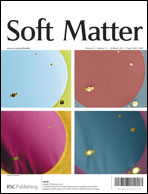Molecular dynamics simulation studies of platelets with square cross-sectional area: formation of a stable cubatic phase
Abstract
Computer simulation studies are reported for the bulk phase behaviour of a colloidal platelet with square cross-sectional area. The platelets studied are composed of fused WCA spheres, have an approximate aspect ratio of 0.26 and are studied by means of molecular dynamics simulations at constant NpT and NVT. The platelets exhibit isotropic, cubatic and columnar phases for different pressures/densities, with phase transitions observed for both the isotropic to cubatic and (for the first time) the columnar to cubatic transition. Application of an oscillatory shear to the cubatic phase results in the formation of a well-ordered nematic phase (of lower viscosity than the cubatic), with the cubatic phase recovered on the removal of shear. Results for the translational and angular velocity auto correlation (VAC) functions and the reorientational correlation functions indicate that particle relaxation times are very slow in both the cubatic and columnar mesophases. In particular, the transition to the cubatic phase (from the isotropic liquid) is characterised by a large increase in the relaxation times for the reorientational correlation functions, which are over 1000x slower to decay than the VACs.


 Please wait while we load your content...
Please wait while we load your content...